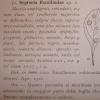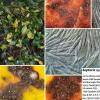
07-02-2017 21:56
En rama de palmera (Phoenix canariensis)A ver que

01-02-2017 01:07
 Miguel Ángel Ribes
Miguel Ángel Ribes
Good nightThis small (500-600 µm) black ball with

06-02-2017 20:07
Vivien HodgeThis Arnium was first found on 3-2-2017 on cow (Bo

06-02-2017 19:56
Hi to everybody. Hi Christian (by the way, what a

06-02-2017 06:44
Ethan CrensonIn Brooklyn, NYC on hardwood, possibly Fagus. In

06-02-2017 02:41
Ethan CrensonFound this on cones of Pinus sylvestris in Brookly
Literature search
Chris Yeates,
22-10-2016 23:49
 Bonsoir tous
Bonsoir tousThis is a second attempt so I have little hope of success :(
I am trying to find the description of Septoria escalloniae A. Agostini, in Archo bot. Sist. Fito-geogr. Genet. 3: 171 (1927).
If anyone can help I would be very grateful.
Amitiés
Chris
Eric Strittmatter,
23-10-2016 07:51
Re : Literature search
Hi Chris,
maybe you are looking for: AGOSTINI, Angela (1927): Contribuzione alla Flora micologica del Senese (Nota seconda). Archivio botanico per la sistematica fitogeografia e genetica (Forli) 3: 165-174. It seems to be held at the "Haus unter den Linden" in Berlin. If you wish, I could make an attempt to get a scan from there. Yet, this may take some time.
Best wishes,
Eric
maybe you are looking for: AGOSTINI, Angela (1927): Contribuzione alla Flora micologica del Senese (Nota seconda). Archivio botanico per la sistematica fitogeografia e genetica (Forli) 3: 165-174. It seems to be held at the "Haus unter den Linden" in Berlin. If you wish, I could make an attempt to get a scan from there. Yet, this may take some time.
Best wishes,
Eric
Eric Strittmatter,
06-02-2017 18:40
Re : Literature search
Dear Chris,
Berlin delivered at last, so here you go. The full reference is: Agostini, Angela (1927) - Contribuzione alla Flora Micologica del Senese (Nota Seconda). Archivio Botanico per la Sistematica, Fitogeografia e Genetica. 3 : 165-174. The description of S. escalloniae is on p. 171.
Best wishes,
Eric
Berlin delivered at last, so here you go. The full reference is: Agostini, Angela (1927) - Contribuzione alla Flora Micologica del Senese (Nota Seconda). Archivio Botanico per la Sistematica, Fitogeografia e Genetica. 3 : 165-174. The description of S. escalloniae is on p. 171.
Best wishes,
Eric
Chris Yeates,
07-02-2017 22:48

Re : Literature search
Hallo Eric
thank you very much for your kind efforts. This enables me to see that the Septoria I have found, often in great quantity where it occurs, is not that species. I think it is undescribed and is almost certainly the same as the one Brian Spooner (pers. comm.) is intending to publish.
LG
Chris
thank you very much for your kind efforts. This enables me to see that the Septoria I have found, often in great quantity where it occurs, is not that species. I think it is undescribed and is almost certainly the same as the one Brian Spooner (pers. comm.) is intending to publish.
LG
Chris

